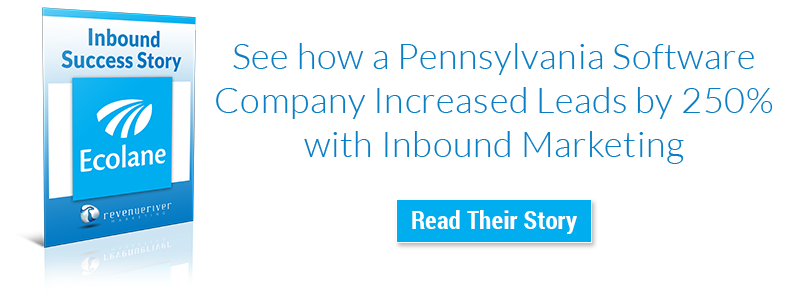How to Grow Your Business Using Account-Based Marketing and Inbound Marketing Tactics

.png?width=650&name=SPRINGTIME%20(1).png)
If a tree falls in a forest and no one is around to hear it, does it make a sound?
If a basic bitch orders a Unicorn Frappuccino from Starbucks but doesn’t Instagram it, did it even happen?
Are inbound marketing and account-based marketing tactics mutually exclusive?
These are the hard-hitting questions that we need answers to.
As for the first two, I’ll let you get all philosophical and figure it out on your own. For the last one, I’ve done the legwork for you.
It turns out, account-based marketing and inbound marketing, while they are not the same thing, are actually quite complementary and can drive powerful results when used together. In fact, I would even argue that account-based marketing cannot be successful without using the foundational elements of inbound marketing to execute this strategy properly.
Using Account-Based & Inbound Marketing Tactics Together
Just to clear the air, the main difference between ABM and inbound marketing is that ABM is all about marketing to all decision makers within a target company at once whereas inbound marketing targets individuals from many organizations. If we use a fishing analogy, inbound marketing is like fishing with a big net while ABM is like spear-fishing.
This doesn’t mean that the two can’t be approached in similar fashions from a strategic standpoint, however. Inbound marketing is all about adapting to the way that people want to shop and buy. ABM requires marketers and salespeople to take an extremely personalized approach to a handful of accounts. See how they go together hand-in-hand?
So, if you’re looking to grow your business, using account-based marketing (ABM) tactics and inbound marketing tactics together can prove to be quite successful. With that in mind, here are some typical inbound marketing strategy tactics that you can actually apply to account-based marketing to create one bitchin' campaign strategy.
1. Content Creation
Even though content creation is more of an inbound tactic and isn’t typically seen as much in account-based marketing, it can still be leveraged successfully. You can develop prospect-specific offers or blog articles, for example. Because an ABM program will likely have a smaller number of target accounts, offers will need to deliver high conversion rates. So, if you can really personalize your content marketing efforts to build offers or articles specifically for a target account, your chances of having your company resonate with those key decision-makers is much higher. In this instance, content will be much more specific than it could ever be in inbound marketing, but still uses the same principles and wants to achieve the same goal.
2. Social Media
In inbound marketing, social media is typically used to amplify content and drive traffic back to your site in an effort to get leads to convert. With account-based marketing, you can use social media to engage with specific target accounts and prospects. You can follow individuals and companies and create monitoring streams for their handles, specific hashtags, or mentions of them. You can then directly send them the content you want them to see and try to start building a relationship with them. Facebook also allows you to do account-based targeting by uploading a list of specific contacts to do targeted ads to based on their email address and LinkedIn allows you to target individuals based on the company that they work for.
3. Email Marketing
Email marketing in ABM can be seen as more of an outbound tactic, so it can get tricky and even spammy. In inbound, email is typically used for nurturing as people have already opted-in. However, if you do your research and take an inbound marketing approach, it can still be successful.
Prospects in ABM still go through the buyer’s journey, so they can still benefit from receiving emails that are highly personalized with a lot of context and helpful content included. These emails can still be used to nurture them through their own buyer’s journey and make them want to engage with your company. You may have to go in a little blind at first, but if you can get your target audience to start engaging with your content and take action on your site, you can start sending them emails based on what they are showing interest in and can identify opportunities to help them.
4. Personalization & Smart Content
With ABM, it’s all about taking an extremely personalized approach to a handful of target accounts. With inbound, we also want to adapt to the way people shop and buy and make it a personalized experience.
Personalization tokens and smart content can be extremely effective in this instance. If you already know who these companies and individuals are, you can use this to your advantage to make sure they are still receiving an extremely personalized experience on your site every time that they visit. You can build smart rules for CTAs and utilize smart content on your site that will change to give them a custom message on certain pages based on the information that you know about them. This is the ultimate dream for inbound marketers, but we often can’t get that specific because we are going after a lot of different individuals that will fall under a general persona versus knowing exactly who a prospect that we want to target is and going after them and them alone.
5. Sales Enablement
Things can get a little backwards with ABM because prospects are known ahead of time. Since sales is often the one who sought them out through prospecting versus inbound marketing where leads are qualified and nurtured by marketing before getting passed off to sales, it may seem that ABM sales teams can't benefit from sales enablement the way that inbound marketing sales teams can, but that isn't the case. To assist in their outreach efforts, marketing should be helping sales build specific content for the prospects that sales would like to target and should also help inject inbound best practices into their communications with the account in order to really make their ABM strategy come alive.
Growing Your Business with Both Strategies
To grow your business using both account-based marketing and inbound marketing tactics, you can leverage both ABM and inbound marketing tactics for lead generation, but you still should lean on your online presence, content, and influence that are built through your inbound marketing tactics to close the deal.
Consider using inbound marketing as your primary strategy since it is more sustainable in the long-term, but inject account-based marketing as well. You can do this by identifying if there are companies that fit your ideal customer profile. This will allow you to go after them instead of having them come to you. Using your foundational inbound tactics to successfully engage with them, you can turn them into a customer while still also continuously generating qualified inbound leads to fill your pipeline through your main inbound marketing strategy.
Using a combination of both makes for a well-oiled marketing machine that will allow your business to continue growing, and that’s what every business owner wants!
